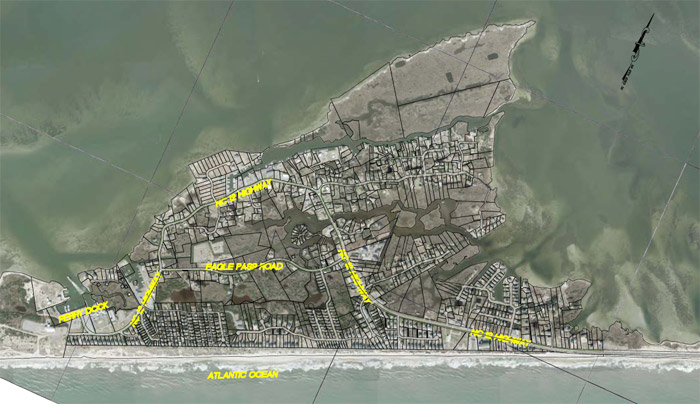
With the recent approval by the Dare County Board of Commissioners (BOC) to award a $342,640 Tourism Impact Grant from the Dare County Tourism Board for the Hatteras Village Multi-Modal Pathway, hopes are high that actual construction on the years-long project can begin soon, and as early as February of 2021.
“The engineers have told us it will be a three-to-four month project, so we’re hoping to start February 1, and by Memorial Day, it will be ready to roll,” said Chairperson for the Hatteras Village Community Center District (HVCCD) and longtime advocate for the project, Ricki Shepherd. “Once the Board of Commissioners approved [the funding] at their last meeting, it was like ‘Merry Christmas for us all!’”
The Hatteras Pathway project was one of seven Outer Banks-wide projects that were earmarked as the recipients of $814,640 in Tourism Impact Grants (TIG).
The designated $342,640 represents about a third of the total pathway project cost, (estimated at around $1 million), and Shepherd says that there is also an additional $342,000 or so that has already been collected through the village’s designation as a special tax district.
In addition, in September of 2020, the Cape Hatteras Electric Cooperative (CHEC) Board of Directors also approved $10,725 to help fund the environmental assessment of the upcoming pathway.
The project itself entails a 3.75-mile paved pathway that will stretch from the Hatteras ferry docks to the northern town borders, and which will include a loop along Eagle Pass Road, making all areas along the route safer and more accessible.
Years in the making, the initial planning for the multi-use pathway in Hatteras village began with a corresponding project to establish the Outer Banks Scenic Byway, which was officially launched in 2016.
In 2013, while the Scenic Byway project was in the works, similar pathways were constructed in Avon and the Tri-village communities of Rodanthe, Waves and Salvo, with a pathway for Hatteras village, (as well as Buxton and Frisco), also on the list of future endeavors.
However, funding for the Hatteras project encountered several hurdles and a little red tape in the years that followed.
In 2017, a N.C. House bill was passed to allow for an election in the Hatteras Village Community Center District to decide whether part of the property tax revenue generated in the district could be used for the construction and maintenance of the multi-use pathway. The HVCCD District is a special tax district in Hatteras Village that was established in 1981, and the district is subject to a special ad valorem tax on all taxable real property for the purpose of maintaining and operating the Hatteras Community Center, and other district-owned properties.
In the May 2018 primary election, the “Pathway Referendum” for Hatteras village residents passed with an impressive 94% of the vote, and survey work for the project began in May of 2019 by Albemarle & Associates, Ltd., (the same company that worked on the existing Tri-villages and Avon pathways).
During this timeframe, Shepherd and her colleagues also spent years applying for a variety of grants to help secure more funds.
“We’ve been working on it forever, because it started way back with the Scenic Byway committee,” said Shepherd. “After the funding [became a challenge], the tax district board decided to pursue this ourselves, and that’s basically what we’ve been doing.”
Currently, stakeholders are waiting to hear about the status of their 2019 application to the Rural Economic Development Loan and Grant (REDLG) program, which provides zero-interest loans to Rural Utilities Service (RUS) eligible borrowers, (generally an electric or telephone cooperative), on the condition that they pass the funds on to an approved project in their community, also at zero percent interest.
“We’ve been pursuing this grant through the electric co-op, and it’s a 10-year, no-interest loan,” said Shepherd. “The great thing is that once the money is paid back, that money stays in the community to be used for other projects. So, when another project comes along that is deemed beneficial for the [community], that pot of money would still be there. That’s the big attraction of the REDLG program.”
But regardless of whether additional funds trickle in or become immediately available through a new loan or grant award, with 66% of the funding now at hand for the project, Shepherd is confident that construction can start in the near future.
“Right now, we are just waiting for our CAMA permit,” she said. “The bid package is ready, so as soon as we have that last bit of info – the permit – we can put the bid package out…”
“We hope the REDLG grant will provide the funds for the last third of the project, but we have a couple of other sources of potential funding as well… We’re really fortunate that we have the [special] tax district, and that we have the funds to be able to do things like this – it’s a really big deal.”
A 7.6-mile Buxton / Frisco Pathway is also slowly in the works, with a feasibility study released to the public in 2019, although like the Hatteras project, funding has been a prevalent concern over the years.
But with the recent award of $342,640 at Monday’s BOC meeting, the Hatteras Pathway, at least, has a much brighter and clarified future, and may be up and running by the time summer officially arrives.
“A huge thanks goes out to the Dare County Board of Commissioners and the [Outer Banks] Visitors Bureau,” said Shepherd. “With two-thirds of the funding [in place], we should be able to do the whole project at once, instead of in pieces, which is our desire.”
“I feel like we’re in a really great position now, and we’re feeling pretty good about [the project], and what’s to come.”








